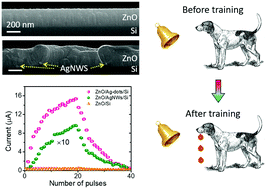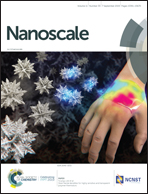Controllable digital resistive switching for artificial synapses and pavlovian learning algorithm†
Abstract
The fundamental unit of the nervous system is a synapse, which is involved in transmitting information between neurons as well as learning, memory, and forgetting processes. Two-terminal memristors can fulfil most of these requirements; however, their poor dynamic changes in resistance to input electric stimuli remain an obstacle, which must be improved for accurate and quick information processing. Herein, we demonstrate the synaptic properties of ZnO-based memristors, which were significantly enhanced (∼340 times) by geometrical modulation due to the localized electric field enhancement. Specifically, by inserting Ag-nanowires and Ag-dots into the ZnO/Si interface, the resistive switching could be controlled from a digital to analog mode. A finite element simulation revealed that the presence of Ag could enhance the localized electric field, which in turn improved the migration of ionic species. Further, the device showed a variety of comprehensive synaptic functions, for instance, paired-pulse facilitation and transformation from short-term plasticity to long-term plasticity, including the Pavlovian associative learning process in a human brain. Our study presents a novel architecture to enhance the synaptic sensitivity, and its uses in practical applications, including the artificial learning algorithm.



 Please wait while we load your content...
Please wait while we load your content...